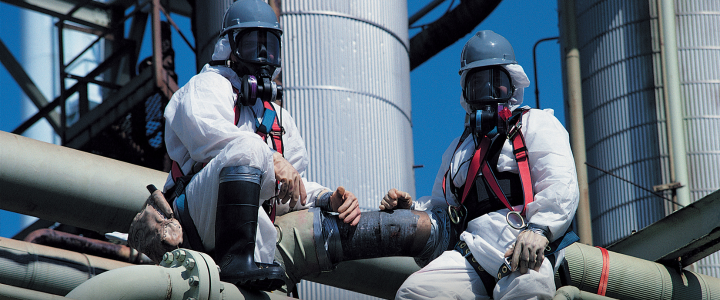Asbestos safety might not be the most exciting topic, but it’s one of the most important. Taking the time to educate your team and put proper precautions in place can make all the difference. You must show your employees that their health and safety matter because when they feel valued and protected, everyone wins.
What is Asbestos & Why Is It Dangerous?
Asbestos is a naturally occurring mineral that was once widely used in construction and manufacturing due to its heat resistance and durability. However, when its fibers are disturbed, they can become airborne and inhaled, leading to severe health problems.
Prolonged asbestos exposure is linked to:
- Mesothelioma: A rare and aggressive form of cancer.
- Asbestosis: Chronic scarring of lung tissue.
- Lung Cancer: Often developing years after exposure.
The symptoms of asbestos-related diseases may not appear until decades later, making early awareness and prevention essential.
Where is Asbestos Found in the Workplace?
Employees might encounter asbestos in older facilities, especially in:
- Insulation materials
- Roofing and flooring tiles
- Cement pipes
- Boilers and heating systems
- Sprayed-on fireproofing materials
- HVAC ducts and systems
- Electrical panels and wiring insulation
- Gaskets and seals
Even seemingly minor tasks, like drilling or renovating, can release asbestos fibers into the air if proper precautions aren’t taken.
Why Every Employer Should Take Asbestos Risks Seriously
It’s on you to tackle asbestos risks and keep your team safe. It’s the right thing to do (and it’s the law).
Compliance with Regulations
Following the rules isn’t optional. OSHA mandates strict regulations to minimize asbestos exposure in the workplace.
Section 1910.1001, also known as the Asbestos Standard, sets guidelines to protect workers from the dangers of asbestos exposure in the workplace. It requires employers to implement safety measures to minimize exposure, such as conducting air monitoring, providing protective equipment, and maintaining a written asbestos exposure control plan. Employers must also train workers on the hazards of asbestos, ensure proper handling and disposal of asbestos-containing materials, and provide medical examinations for workers who may be exposed to high levels of asbestos.
Protecting Employee Health
Educating workers about asbestos equips them to recognize potential hazards and take appropriate steps to avoid exposure. When employees know what to watch for and how to handle risks, they’re less likely to face serious health issues down the road.
Reducing Liability
A workplace incident involving asbestos exposure can lead to costly legal battles and damage to your organization’s reputation. Proactive awareness and safety training courses can help mitigate these risks.

5 Steps for Asbestos Safety Awareness
Following these steps will make your workplace a much safer environment.
1. Provide Asbestos Training
Ensure all employees receive training tailored to their roles, covering topics such as:
- Identifying asbestos-containing materials (ACMs)
- Safe handling and disposal procedures
- Emergency response protocols
2. Conduct Regular Inspections
Have certified professionals inspect older buildings and equipment for asbestos. Knowing where it’s located is the first step in managing the risk.
3. Establish a Clear Reporting Procedure
Make it easy and stress-free for employees to report damaged materials or potential asbestos-containing materials (ACMs). A clear reporting process is really all about catching problems before they turn into bigger risks.
You should also encourage your team to speak up as soon as they spot something suspicious, and make sure they know who to contact and how. Open communication can be the difference between a minor fix and a major health hazard.
4. Use Proper Safety Gear
Provide employees with the right PPE to reduce the risk of exposure. This includes items like respirators, which help filter out asbestos fibers from the air, and protective suits to prevent asbestos particles from settling on clothing and skin. Workers should also wear gloves and safety goggles to protect their hands and eyes.
Tip: Regularly inspect and maintain the equipment to ensure it remains effective.
5. Control Dust and Debris
Implement containment measures during renovation or repair projects to prevent asbestos fibers from becoming airborne.
Partnering with Safety Experts
Safety by Design specializes in workplace safety solutions, including asbestos awareness training and hazard assessments. Managing asbestos risks can be complex, but you don’t have to do it alone! Our third-party safety consulting team can help you create a safer work environment that protects your employees and your business.
If you’re ready to take the next step in asbestos awareness, reach out to Safety by Design today!



